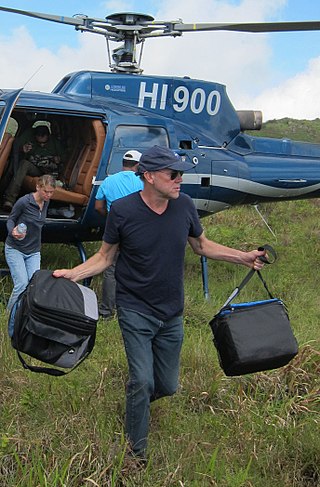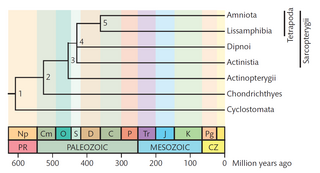Related Research Articles

Paleontology, also spelled palaeontology or palæontology, is the scientific study of life that existed prior to, and sometimes including, the start of the Holocene epoch. It includes the study of fossils to classify organisms and study their interactions with each other and their environments. Paleontological observations have been documented as far back as the 5th century BC. The science became established in the 18th century as a result of Georges Cuvier's work on comparative anatomy, and developed rapidly in the 19th century. The term has been used since 1822 formed from Greek παλαιός, ὄν, and λόγος.

A tetrapod is any four-limbed vertebrate animal of the superclass Tetrapoda. Tetrapods include all extant and extinct amphibians and amniotes, with the latter in turn evolving into two major clades, the sauropsids and synapsids. Some tetrapods such as snakes, legless lizards, and caecilians had evolved to become limbless via mutations of the Hox gene, although some do still have a pair of vestigial spurs that are remnants of the hindlimbs.

Synapsida is one of the two major clades of vertebrate animals in the group Amniota, the other being the Sauropsida. The synapsids were the dominant land animals in the late Paleozoic and early Mesozoic, but the only group that survived into the Cenozoic are mammals. Unlike other amniotes, synapsids have a single temporal fenestra, an opening low in the skull roof behind each eye orbit, leaving a bony arch beneath each; this accounts for their name. The distinctive temporal fenestra developed about 318 million years ago during the Late Carboniferous period, when synapsids and sauropsids diverged, but was subsequently merged with the orbit in early mammals.

Vertebrate paleontology is the subfield of paleontology that seeks to discover, through the study of fossilized remains, the behavior, reproduction and appearance of extinct vertebrates. It also tries to connect, by using the evolutionary timeline, the animals of the past and their modern-day relatives.

Ophidia is a group of squamate reptiles including modern snakes and reptiles more closely related to snakes than to other living groups of lizards.
The Archonta are a now-abandoned group of mammals, considered a superorder in some classifications, which consists of these orders:

Michael James Benton is a British palaeontologist, and professor of vertebrate palaeontology in the School of Earth Sciences at the University of Bristol. His published work has mostly concentrated on the evolution of Triassic reptiles but he has also worked on extinction events and faunal changes in the fossil record.

Evolution of the Vertebrates, subtitled "A History of the Backboned Animals Through Time" is a basic paleontology textbook by Edwin H. Colbert, published by John Wiley & Sons.

Paleobiology is an interdisciplinary field that combines the methods and findings found in both the earth sciences and the life sciences. Paleobiology is not to be confused with geobiology, which focuses more on the interactions between the biosphere and the physical Earth.
The tree of life or universal tree of life is a metaphor, conceptual model, and research tool used to explore the evolution of life and describe the relationships between organisms, both living and extinct, as described in a famous passage in Charles Darwin's On the Origin of Species (1859).
The affinities of all the beings of the same class have sometimes been represented by a great tree. I believe this simile largely speaks the truth.
Diarthrognathus is an extinct genus of tritheledontid cynodonts, known from fossil evidence found in South Africa and first described in 1958 by A.W. Crompton. The creature lived during the Early Jurassic period, about 200 million years ago. It was carnivorous and small, slightly smaller than Thrinaxodon, which was under 50 centimetres (20 in) long.
Tyler R. Lyson is an American paleontologist. He is the discoverer of the dinosaur fossil Dakota, a fossilized mummified hadrosaur. He has done significant research on the evolution of turtles and on the rise of mammals after the extinction of the dinosaurs.
The following is a chronological list of 148 television series and individual programmes in which Sir David Attenborough is credited as a writer, presenter, narrator, producer, or interviewee. In a career spanning eight decades, Attenborough's name has become synonymous with the natural history programmes produced by the BBC Natural History Unit.
First Life is a 2010 British nature documentary series written and presented by David Attenborough, also known by the expanded titles David Attenborough's First Life (UK) and First Life with David Attenborough (USA). It was first broadcast in the US as a two-hour special on the Discovery Channel on 24 October 2010. In the United Kingdom it was broadcast as a two-part series on BBC Two on 5 November 2010. First Life sees Attenborough tackle the subject of the origin of life on Earth. He investigates the evidence from the earliest fossils, which suggest that complex animals first appeared in the oceans around 540 million years ago, an event known as the Cambrian Explosion. Trace fossils of multicellular organisms from an even earlier period, the Ediacaran biota, are also examined. Attenborough travels to Canada, Morocco and Australia, using some of the latest fossil discoveries and their nearest equivalents amongst living species to reveal what life may have been like at that time. Visual effects and computer animation are used to reconstruct and animate the extinct life forms. Attenborough's Journey, a documentary film profiling the presenter as he journeyed around the globe filming First Life, was shown on BBC Two on 24 October 2010. A hardback book to accompany the series, authored by Matt Kaplan with a foreword by Attenborough, was published in September 2010.

Reptiles arose about 320 million years ago during the Carboniferous period. Reptiles, in the traditional sense of the term, are defined as animals that have scales or scutes, lay land-based hard-shelled eggs, and possess ectothermic metabolisms. So defined, the group is paraphyletic, excluding endothermic animals like birds that are descended from early traditionally-defined reptiles. A definition in accordance with phylogenetic nomenclature, which rejects paraphyletic groups, includes birds while excluding mammals and their synapsid ancestors. So defined, Reptilia is identical to Sauropsida.

Edwin Harris "Ned" Colbert was a distinguished American vertebrate paleontologist and prolific researcher and author.

Patricia Arlene Vickers-Rich, also known as Patricia Rich, is an Australian Professor of Palaeontology and Palaeobiology, who researches the environmental changes that have impacted Australia and how this shaped the evolution of Australia’s fauna and flora.

TimeTree is a free public database developed by S. Blair Hedges and Sudhir Kumar, now at Temple University, for presenting times of divergence in the tree of life.. The basic concept has been to produce and present a community consensus of the timetree of life from published studies, and allow easy access to that information on the web or mobile device. The database permits searching for average node times between two species or higher taxa, viewing a timeline from the perspective of a taxon, which shows all divergences back to the origin of life, and building a timetree of a chosen taxon or user-submitted group of taxa. TimeTree has been used in public education to conceptualize the evolution of life, such as in high school settings. David Attenborough's Emmy Award-winning film and television program Rise of Animals used Hedges and Kumar's circular timetree of life, generated from the TimeTree database, as a framework for the production. The timetree was brought to life using animated computer-generated imagery in scenes every 10 minutes during the 2-hour movie. The original development of TimeTree, by Hedges and Kumar, dates to the late 1990s, with initial support from NASA Astrobiology Institute. Since then, it has been supported by additional grants from NASA, and by NSF and NIH. The current version (v5) was released in 2022 and contains data from 4,075 studies and 137,306 species.

Stephen Blair Hedges is Laura H. Carnell Professor of Science and director of the Center for Biodiversity at Temple University where he researches the tree of life and leads conservation efforts in Haiti and elsewhere. He co-founded Haiti National Trust.

A timetree is a phylogenetic tree scaled to time. It shows the evolutionary relationships of a group of organisms in a temporal framework.
References
- ↑ Hedges, S. Blair; Kumar, Sudhir (2009). The Timetree of Life. Oxford University Press. ISBN 978-0199535033.